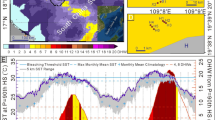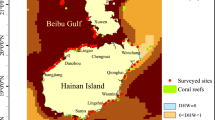Abstract
The Andaman coral reef region experienced mass bleaching events during 1998 and 2010. The purpose of this study is to investigate the role of the El Niño in the coral reef bleaching events of the Andaman region. Both Niño 3.4 and 3 indices were examined to find out the relationship between the mass bleaching events and El Niño, and correlated with sea surface temperature (SST) anomalies in the Andaman Sea. The result shows that abnormal warming and mass bleaching events in the Andaman Sea were seen only during strong El Niño years of 1997–1998 and 2009–2010. The Andaman Sea SST was more elevated and associated with El Niño Modoki (central Pacific El Niño) than conventional El Niño (eastern Pacific El Niño) occurrences. It is suggested that the development of hot spot patterns around the Andaman Islands during May 1998 and April–May 2010 may be attributed to zonal shifts in the Walker circulation driven by El Niño during the corresponding period.









Similar content being viewed by others
References
Ashok, K., & Yamagata, T. (2009). Climate Change: The El Niño with a difference. Nature, 461, 481–484.
Baker, A. C., Glynn, P. W., & Riegl, B. (2008). Climate change and coral reef bleaching: an ecological assessment of long-term impacts, recovery trends and future outlook. Estuarine, Coastal and Shelf Science, 80, 435–471.
Brown, B. E. (1997). Coral bleaching: causes and consequences. Coral Reefs, 16, S129–S138.
Donner, S. D. (2005). Global assessment of coral bleaching and required rates of adaptation under climate change. Global Change Biology, 11, 2251–2265.
English, S., Wilkinson, C., & Baker, V. (1997). Survey manual for tropical resources. Australian Institute of Marine Sciences, Townsville, Australia, 2nd edition, pp.390.
Glynn, P. W. (1991). Coral reef bleaching in the 1980s and possible connections with global warming. Trends in Ecology and Evolution, 6, 175–179.
Glynn, P. W. (1993). Coral reef bleaching: ecological perspectives. Coral Reefs, 12, 1–17.
Goreau, T. J., Hayes, R. L., Clark, J.W., Basta, D. J., & Robertson, C. N. (1993). Elevated sea surface temperatures correlate with Caribbean coral reef bleaching, in: Geyer, R. A. (Ed), A global warming forum: Scientific, Economic, and Legal Overview, CRC press, Boca Raton, pp. 225–255.
Goreau, T. J., & Hayes, R. L. (1994). Coral bleaching and ocean “HotSpots”. Ambio, 23, 176–180.
Hoegh-Guldberg, O. (1999). Climate change, coral bleaching and the future of the world’s coral reefs. Marine Fresh Water Research, 50, 839–866.
Hoegh-Guldberg, O., & Salvat, B. (1995). Periodic mass bleaching and elevated sea temperature: bleaching of outer reef slope communities in Moorea, French Polynesia. Marine Ecology Progress Series, 121, 181–190.
Hoegh-Guldberg, O., Mumby, P. J., Hooten, A. J., Steneck, R. S., Greenfield, P., Gomez, E., Harvell, C. D., Sale, P. F., Edwards, A. J., Caldeira, K., Knowlton, N., Eakin, C. M., Iglesias-Prieto, R., Muthiga, N., Bradbury, R. H., Dubi, A., & Hatziolos, M. E. (2007). Coral reefs under rapid climate change and ocean acidification. Science, 318, 1737–1742.
Huges, T. P., Baird, A. H., Bellwood, D. R., Card, M., Connolly, S. R., Folke, C., Grosberg, R., Hoegh-Guldberg, O., Jackson, J. B. C., Kleypas, J., Lough, J. M., Marshall, P., Nystrom, M., Palumbi, S. R., Pandolfi, J. M., Rosen, B., & Roughgarden, J. (2003). Climate change, human impacts and resilience of coral reefs. Science, 301, 929–933.
Jokiel, P. L., & Coles, S. L. (1990). Responses of Hawaiian and other Indo-Pacific reef corals to elevated temperature. Coral Reefs, 8, 155–162.
Klein, S. A., Soden, B. J., & Lau, N. (1999). Remote sea surface temperature variations during ENSO: evidence for a tropical atmospheric bridge. Journal of Climate, 12, 917–932.
Krishnan, P., Dam Roy, S., George, G., Srivastava, R. C., Anand, A., Murugesan, S., Kaliyamoorthy, M., Vikas, N., & Soundararajan, R. (2011). Elevated sea surface temperature during May 2010 induces mass bleaching of corals in the Andaman. Current Science, 100, 111–117.
Lee, T., & Mc Phaden, M. J. (2010). Increasing intensity of El Niño in the central equatorial Pacific. Geophysical Research Letters, 37, doi: 10.1029/2010 GL044007.
Liu, G., Strong, A. E., & Skirving, W. (2003). Remote sensing of sea surface temperature during 2002 Barrier Reef coral bleaching. Eos, 84, 137–144.
MacKellar, M. C., & McGowan, H. A. (2010). Air-sea energy exchanges measured by eddy covariance during a localised coral bleaching event, Heron Reef, Great Barrier reef, Australia. Geophysical Research Letters, 37, doi: 10.1029/2010GL045291.
McGowan, H. A., Sturman, A. P., MacKellar, M. C., Wiebe, A. H., Neil, D. T. (2010). Measurements of the local energy balance over a coral reef flat, Heron Island, southern Great Barrier Reef, Australia. Journal of geophysical research, 115, doi: 10.1029/2010JD014218.
Mc Phaden, M. J., Lee, T., & Mc Clurg, D. (2011). El Nino and its relationship to changing background conditions in the tropical pacific Ocean. Geophysical Research Letters, 38, doi: 10.1029/2011GL048275.
Miller, M. W., Piniak, G. A., & Williams, D. E. (2011). Coral mass bleaching and reef temperatures at Navassa Island, 2006. Estuarine, Coastal and Shelf Science, 91, 42–50.
Mohanty, P. C., Mahendra, R. S., Bisoyi, H., Tummula, S. K., Grinson, G., Nayak, S., & Sahu, B. K. (2013). Assessment of the coral bleaching during 2005 to decipher the thermal stress in the coral environs of the Andaman Island using remote sensing. European Journal of Remote Sensing, 46, 417–430.
Pet-Soede, L., Wafar, M., Venkataraman, K., Rajan, P. T., & Wilhelmsson, D. (2000). The status of the coral reefs of India following the bleaching event of 1998, in: Souter, D., Obura, D. & Linden, O. (Ed.), Coral reef Degradation in the Indian Ocean, status report 2000, CORDIO, SAREC Marine science Program, Stockholm University, Sweden, pp. 69–74
Rajasuriya, A., Maizan, H. M., Subramaniam, B. R., & Jason, R. (1999). Coral reef ecosystems in South Asia. Coral reef degradation in the Indian Ocean: Status reports and project presentations 1999, pp. 10–23.
Ravindran, J., Raghukumar, C., & Raghukumar, S. (1998). Disease and stress-induced mortality of corals in Indian reefs and observations on bleaching of corals in the Andamans. Current Science, 76, 233–236.
Roy, S. D., Krishnan, P., & George Grinson. (2006). Assessment of coral reef health using satellite data, in: Srivastava, R. C., Ganesh Kumar, B., Jayakumar, V., Domodaran, T., Ravisankar, N., Jeyakumar, S., George Grinson, & Tomar Simmi, (Ed.), Annual report 2005–06. Central Agricultural Research Institute, Port Blair, pp73–74.
Roy, S. D., George, G., Soundararajan, R., Krishnan, P., Murugesan, S., & Kaliyamoorthy, M. (2014). Status of coral reefs in Andaman after two major catastrophic events—tsunami of December 2004 and bleaching of May 2005. Ecology Environment and Conservation, 20, 539–544.
Sebens, K. P. (1994). Biodiversity of coral reefs: what are we using and why? American Zoologist, 34, 115–133.
Sengupta, D., & Ravichandran, M. (2001). Oscillations of Bay Of Bengal sea surface temperature during the 1998 summer monsoon. Geophysical Research Letters, 28, 2033–2036.
Sheppard, C. R. C. (2003). Predicted recurrences of mass coral mortality in the Indian Ocean. Nature, 425, 294–297.
Stone, L., Huppert, A., Rajagopalan, B., Bhasin, H., & Loya, Y. (1999). Mass coral reef bleaching: a recent outcome of increased El Niño activity? Ecology Letters, 2, 325–330.
Tun, K., Chou, L. M., Low, J., Yeemin, T., Phongsuwan, N., Setiasich, N., Wilson, J., Amri, A. Y., Abdul Adzis, K. A., Lane, D., Bochove, J. V., Kluskens, B., Long, N. V., Tuan, V. S., & Gomez, E. (2010). Status of Coral reefs in East Asian Seas region: 2010. A regional overview on the 2010 coral bleaching event in Southeast Asia, Ministry of the Environment, Japan, Chapter 1.1, pp. 9–26.
Vivekanandan, E., Ali, M. H., Jasper, B., & Rajagopalan, M. (2008). Thermal thresholds for coral bleaching in the Indian seas. Journal of Marine Biological Association of India, 50, 209–214.
Wang, C., Deser, C., Yu,J. Y., DiNezio, P., & Clement, A. (2012). El Niño and Southern Oscillation (ENSO): A review. A chapter for Springer book; Coral reefs of the Eastern Pacific.
Wilkinson, C. (1998). Status of the coral reefs of the world: 1998. The 1997–1998 Mass bleaching event around the world, Chapter 1, pp.15-37.
Wilkinson, C. R. (2002). Status of coral reefs of the world: Global Coral reef monitoring network, Townsville, Australia, p. 5.
Wilkinson, C., Linden, O., Cesar, H., Hodgson, G., Rubens, J., & Strong, A. E. (1999). Ecological and socioeconomic impacts of 1998 coral mortality in the Indian Ocean: an ENSO impact and a warning of future change? Ambio, 28, 188–196.
Winter, A., Appeldoorn, R. S., Bruckner, A., Williams, E. H., & Goenaga, C. (1998). Sea surface temperatures and coral reef bleaching off La Parguera, Puerto Rico (northeastern Caribbean Sea). Coral Reefs, 17, 377–382.
World Meteorological Organization, (2010). 2010 in the top three warmest years, 2001–2010 warmest 10-year period. http://www.wmo.int/pages/mediacentre/press_releases/pr_904_en.html
Yeh, S. W., Kug, J. S., Dewitte, B., Kirtman, B. P., & Jin, F. F. (2009). Recent changes in El Niño and its projection under global warming. Nature, 461, 511–515.
Yu, J. Y., Kao, H. Y. (2007). Decadal changes of ENSO persistence barrier in SST and ocean heat content indices: 1958–2001. Journal of Geophysical Research, 112, doi: 10/1029/2006JD007654.
Acknowledgments
We thank the Ministry of Earth Sciences, Govt. of India, for funding this project and the members of the National Expert committee for evolving the National Data Buoy programme. We also thank the staff of the Ocean Observation Systems Group of NIOT. We express our gratitude to the Department of Environment and Forest, Andaman & Nicobar Administration and Andaman & Nicobar Centre for Ocean Science and Technology-Ocean Science and Technology for Islands of NIOT. The authors would like to acknowledge Scientists and Director, Central Agricultural Research Institute, Port Blair for their inputs on coral studies. Help rendered in by Rahul G Kumar, NBFGR Unit, Kochi is acknowledged.
Author information
Authors and Affiliations
Corresponding author
Rights and permissions
About this article
Cite this article
Lix, J.K., Venkatesan, R., Grinson, G. et al. Differential bleaching of corals based on El Niño type and intensity in the Andaman Sea, southeast Bay of Bengal. Environ Monit Assess 188, 175 (2016). https://doi.org/10.1007/s10661-016-5176-8
Received:
Accepted:
Published:
DOI: https://doi.org/10.1007/s10661-016-5176-8




